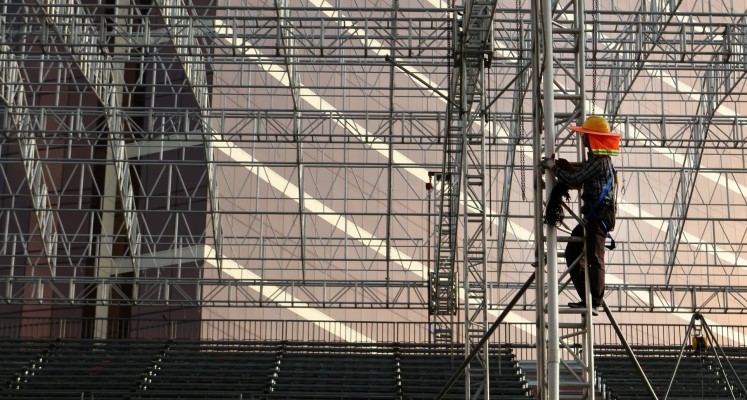
Being in the scaffolding trade carries a higher risk than with many other businesses. Whether you operate a scaffolding company or work on a self-employed basis, you will need to have the correct insurance. According to NimbleFins, scaffolding insurance is quite expensive compared to business insurance for other trades. This is primarily due to the risks involved.
In the case of scaffolding businesses that hire employees, employer’s liability will be a legal requirement. Plus, all scaffolders need to be covered by public liability insurance to protect against injuries to members of the public or other third parties. There are also policies available that provide compensation in the event of accidental death or injury from falling objects. Trips and falls that cause damage to a person or their property are common claims against scaffolders owing to the higher amount of hazards that may be found on and around construction sites. Specialised tools and equipment are required to perform scaffolding services, and operators may elect to purchase coverage to protect their trade tools.
Self-employed scaffolder insurance
Obtaining adequate coverage as a self-employed scaffolder can be done by searching online for an insurance provider. Using a comparison site can help you compare scaffolder insurance quotes quickly and easily. However, if you have questions, you should speak with an insurance advisor or broker before buying a policy.
Coverage levels will need to be carefully assessed to ensure that limits are high enough to protect from any claims brought. Clients, employees, and members of the public can all pursue legal action against a scaffolder, so having the correct protection is important.
For a self-employed scaffolder, insurance may be obtained to provide coverage against:
- Personal injuries and accidents
- Equipment and tools theft and damage
- Vehicle damage
- Third-party injury or damage claims (i.e., public liability)
Some types of insurance are mandatory and required by law, while other policies are not legally required. As scaffolders typically work at height, premiums can be more expensive than for other businesses purchasing the same type of policy. Increased risk equals increased cost, so it is worth making careful quote comparisons to obtain the best deal.
Scaffolders public liability insurance
Being able to protect against any claims brought will be a consideration for any self-employed scaffolder. While public liability insurance is not legally required, scaffolders will be personally exposed to financial risk without it. Any claims brought by a third party can come with costly financial settlement payments, medical costs, and legal fees.
Public liability insurance for self-employed scaffolders may be purchased to protect from the financial impact of third-party claims. Standard coverage amounts are £1, £2, and £5 million but can rise as high as £10 million and higher if needed. The size of the business and other factors can affect policy limits. This type of insurance, while optional, may be demanded by government offices, local authorities, and other clients before being allowed to perform any work on their property.
Other types of scaffolder’s insurance
Personal accidents that render a scaffolder unable to work or accidents resulting in death can be covered by insurance, as can damage to a contractor’s property, tools, vehicles, or damages resulting from theft, accidents, or loss.
Performing work as a scaffolder comes with many risk factors, and these insurance policies are available to guard against incidents and injury.
Personal Injury
Working in the scaffolding industry means that you can be at risk personally of serious bodily harm. Insurance can be purchased to provide coverage in a lump sum payment in the event of an accident or death. The seriousness of the injury usually determines the payout amount, but as risk is high for scaffolders, it is advisable to invest in this type of policy.
Professional Indemnity
Depending on the type of service or advice you are providing, professional indemnity may be required. This insurance protects against claims that arise from negligence or mistakes in your work. Professional indemnity insurance is not required by law, but it may be required by architects, accountants, and legal professionals.
Equipment damage cover
Self-employed scaffolders use a variety of tools and equipment to perform work and services. Protection from damage or theft can be provided by obtaining equipment damage cover. This can be used to repair or replace damaged items and replace any lost or stolen items. This cover won’t usually protect against malfunctions or wear and tear, however.
Vehicle Insurance
Using a van or truck to transport equipment to work sites means that a commercial vehicle or van insurance policy will be needed. This will cover you financially in the event of any accidents, injury, or damage that occurs during travel. It can also include cover for items in the vehicle, such as equipment or tools that are damaged during transportation. Or loss from theft or vandalisation. A minimum of third-party cover is required by law.
How much does a scaffolder earn?
Earnings can vary for scaffolders depending on the type and quantity of work performed. Entry-level operators can expect lower annual incomes, while seasoned scaffolders typically average around £42000 per year. Experienced workers can see much higher amounts with annual salaries reaching as high as £62000 per year and above.
Earnings can be impacted by regional variations, with scaffolders in London seeing larger incomes than those in the north of the country. The urgency of the construction or number of scaffolders in demands can also impact how much money is paid for each job. As a trade, the amount that can be earned by scaffolder’s often exceeds the salaries of many other professions like those of nurses or accountants.







